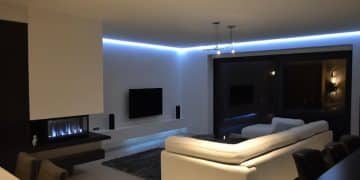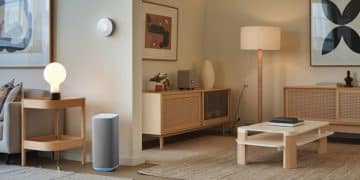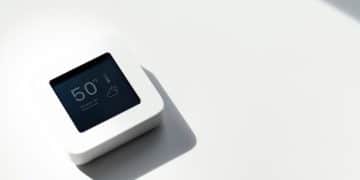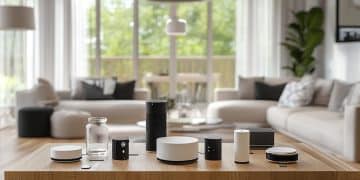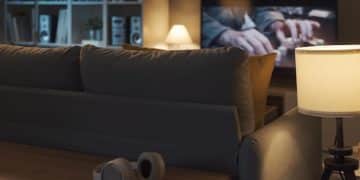Smart Home Accessibility: Assistive Technologies for Seniors in US Homes
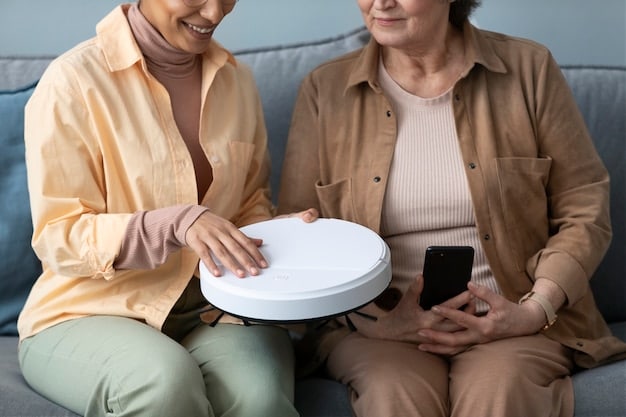
Smart home accessibility solutions offer seniors in US homes enhanced independence through assistive technologies like voice control, smart lighting, and remote monitoring, promoting safety and comfort.
Discover how smart home accessibility technologies can revolutionize the lives of seniors in US homes, providing them with greater independence, safety, and comfort.
Understanding Smart Home Accessibility for Seniors
Smart home accessibility isn’t just a trend; it’s a necessity for many seniors who wish to maintain their independence and age comfortably in their own homes. By integrating technology thoughtfully, we can create environments that cater to their specific needs.
These technologies range from simple adaptations like voice-controlled lighting to more sophisticated systems that monitor health and safety. The goal is to empower seniors, reduce reliance on caregivers, and provide peace of mind for families.
Key Benefits of Smart Home Technology
Smart home technology provides numerous benefits for seniors, improving their quality of life:
- Enhanced Safety: Sensors and monitoring systems can detect falls or other emergencies, alerting caregivers or emergency services.
- Increased Independence: Voice control and automated systems allow seniors to manage their environment without physical exertion.
- Improved Comfort: Smart thermostats and lighting systems can be adjusted to the individual’s preferences, ensuring a comfortable living space.
Smart home accessibility creates an environment where seniors can live more comfortably and safely, reducing stress and enhancing their overall well-being.
Voice-Activated Assistants: A Game Changer
Voice-activated assistants like Amazon Alexa and Google Assistant have become increasingly popular and offer significant benefits for seniors. These devices provide hands-free control over various aspects of the home, promoting independence and ease of use.
From turning on lights to making phone calls, voice assistants simplify everyday tasks. For seniors with limited mobility or dexterity, these devices can be invaluable tools.
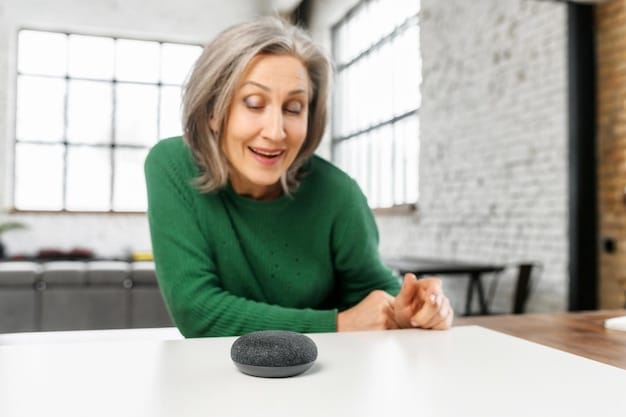
How Voice Assistants Enhance Daily Life
Voice assistants can be used in many ways to improve seniors’ daily routines:
- Hands-Free Control: Control lights, thermostats, and appliances with simple voice commands.
- Communication: Make phone calls, send messages, and stay connected with family and friends.
- Entertainment: Listen to music, audiobooks, and podcasts for entertainment and mental stimulation.
- Information Access: Get answers to questions, set reminders, and manage schedules.
Voice assistants are a simple and effective way for seniors to manage their homes and stay connected with the world around them.
Smart Lighting: Illuminating the Path to Independence
Smart lighting systems offer more than just convenience; they provide enhanced safety and accessibility for seniors. These systems can be programmed to automatically adjust lighting levels, reducing the risk of falls and improving visibility.
With features like motion-activated lights and remote control, smart lighting ensures that seniors can safely navigate their homes at any time of day or night.
Benefits of Smart Lighting for Seniors
Here are some key ways smart lighting can benefit seniors:
- Motion-Activated Lights: Automatically illuminate hallways and rooms when movement is detected, preventing falls and improving visibility.
- Remote Control: Adjust lighting levels from a smartphone or tablet, providing convenience and control.
- Programmable Settings: Set schedules to automatically turn lights on and off, reducing energy consumption and simplifying daily routines.
Smart lighting systems provide a safer and more comfortable living environment for seniors.
Remote Monitoring: Peace of Mind for Families
Remote monitoring systems offer families peace of mind by allowing them to check in on their loved ones remotely. These systems can track activity levels, monitor vital signs, and detect potential emergencies.
With real-time alerts and notifications, families can respond quickly to any issues that may arise, ensuring the safety and well-being of their senior loved ones.
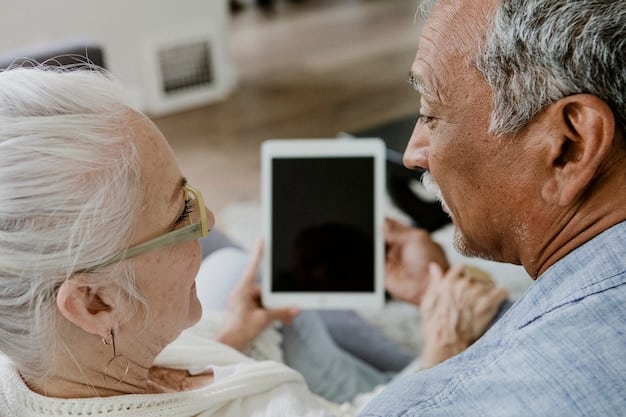
Features of Effective Remote Monitoring Systems
Remote monitoring systems come with a variety of features designed to keep seniors safe and connected:
- Activity Tracking: Monitor daily routines to detect any unusual changes in behavior.
- Vital Sign Monitoring: Track heart rate, blood pressure, and other vital signs to identify potential health issues.
- Emergency Alerts: Receive immediate notifications in the event of a fall or other emergency.
- Two-Way Communication: Communicate with seniors through video calls or messaging, providing companionship and support.
Remote monitoring systems provide valuable insights into seniors’ well-being, allowing families to provide the best possible care.
Smart Thermostats: Creating a Comfortable Environment
Maintaining a comfortable temperature is essential for seniors’ health and well-being. Smart thermostats make it easy to regulate the temperature in the home, ensuring a comfortable living environment regardless of the season.
These devices can be programmed to automatically adjust the temperature based on the time of day or the individual’s preferences, reducing energy consumption and improving comfort.
Advantages of Smart Thermostats for Seniors
Smart thermostats offer several advantages for seniors:
- Remote Control: Adjust the temperature from a smartphone or tablet, providing convenience and control.
- Programmable Schedules: Set schedules to automatically adjust the temperature based on the time of day or the individual’s preferences.
- Energy Savings: Reduce energy consumption by optimizing temperature settings.
Smart thermostats help seniors maintain a comfortable and energy-efficient home environment.
Addressing Concerns and Challenges
While smart home accessibility offers numerous benefits, it’s essential to address potential concerns and challenges. Cost, privacy, and technology adoption are common issues that need to be considered.
By addressing these concerns proactively and providing adequate training and support, we can ensure that seniors can fully benefit from these technologies.
Overcoming Barriers to Adoption
Here are some ways to overcome the barriers to smart home accessibility:
- Affordable Solutions: Explore cost-effective options and government assistance programs to make technology more accessible.
- Privacy Measures: Implement robust security measures to protect seniors’ personal data.
- Training and Support: Provide comprehensive training and ongoing support to help seniors learn how to use the technology effectively.
By addressing these concerns, we can ensure that smart home accessibility is a positive and empowering experience for seniors.
| Key Aspect | Brief Description |
|---|---|
| 💡 Smart Lighting | Improves safety with motion-activated and remote-controlled systems. |
| 🗣️ Voice Assistants | Offers hands-free control for daily tasks, enhancing independence. |
| 🌡️ Smart Thermostats | Maintains comfortable temperatures, remotely controllable. |
| 🚨 Remote Monitoring | Provides peace of mind with activity tracking and emergency alerts. |
Frequently Asked Questions
▼
Voice-activated assistants like Amazon Echo, smart lighting, and remote monitoring systems are highly recommended for enhancing safety and independence in seniors’ homes.
▼
Smart home technology improves safety through features like fall detection, emergency alerts, and remote monitoring, which allow caregivers to respond quickly to potential issues.
▼
Many modern smart home devices are designed with user-friendly interfaces and voice control, making them accessible for seniors with varying levels of technical proficiency.
▼
Remote monitoring systems use sensors and cameras to track activity and vital signs, sending real-time alerts to caregivers or family members via a smartphone or tablet.
▼
Privacy concerns include data security and unauthorized access. Mitigate risks by choosing reputable brands with strong security protocols and regularly updating device software.
Conclusion
Smart home accessibility technologies offer a transformative approach to enhancing independence and improving the quality of life for seniors in US homes. By embracing these assistive technologies, families can create safer, more comfortable, and empowering environments for their loved ones to age in place with dignity and peace of mind.

